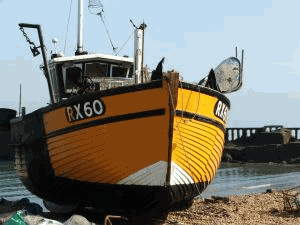Dollars for Trawlers
by Brandon Fuller Trawlers are boats that drag large nets along the bottom of the ocean in an effort to catch ground-fish like cod, haddock, and flounder. As a recent National Public Radio (NPR) story reports, trawler captains along California's central coast made a killing in the early 1980s. Predictably, other trawlers arrived on the scene to get in on the exceptional profits. Dragging a big, weighted net along the ocean floor is not without its environmental impacts. A permit system prevented over-fishing, but the environmental consequences for the seafloor escalated even as a combination of restricted fishing, competition from new trawlers, and rising fuel costs weakened the earnings of central coast trawler captains.
Trawlers are boats that drag large nets along the bottom of the ocean in an effort to catch ground-fish like cod, haddock, and flounder. As a recent National Public Radio (NPR) story reports, trawler captains along California's central coast made a killing in the early 1980s. Predictably, other trawlers arrived on the scene to get in on the exceptional profits. Dragging a big, weighted net along the ocean floor is not without its environmental impacts. A permit system prevented over-fishing, but the environmental consequences for the seafloor escalated even as a combination of restricted fishing, competition from new trawlers, and rising fuel costs weakened the earnings of central coast trawler captains.Enter the Nature Conservancy.
The Nature Conservancy offered to buy fishing permits and trawler boats. After purchasing permits the Conservancy can retire permits entirely or lease them back to the fisherman with a legal constraint on the fisherman's vessel that prohibits trawling. Either way, the trawler buy-out program reduces trawling--those captains who lease permits from the Conservancy are free to fish for permitted species so long as they swear off trawling. The program illustrates an important point. Frequently, the most efficient use of a resource--in this case the seafloor--is its conservation.
1. Fishermen who lease permits from the Conservancy can catch as many fish as the permits allow, provided they use non-trawling techniques. As the NPR story mentions, the federal government is also stepping up efforts to protect swaths of seafloor from trawling.
How will the reduction of trawling along the coast affect the price that California fishermen receive for their catch of ground-fish (the types of fish most commonly caught by trawler nets)? How does the trawler buy-out program affect the trawler captains who choose not to sell their boats or permits to the Conservancy? Do you think the combination of federal regulations and private trawler buy-outs will lead to newer, less environmentally intrusive methods for harvesting ground-fish?
2. The Conservancy's trawler buy-out program is a market-based solution to a negative environmental externality (neither the trawler captains nor the fish consumers incur the environmental costs of seafloor disruption). The government's role is limited to enforcing the contracts between the Conservancy and the fishermen.
How does the Conservancy's approach to conservation differ from that of other environmental groups?
3. Other examples of market-based efforts to curb environmental degradation include greenhouse gas credit buy-outs (see a related Marketplace story here). In what ways are systems of exchangeable permits and credits more efficient vehicles for conservation than government regulations that cap harvests or emissions on a firm-by-firm basis?
Go here for more information on the Nature Conservancy's trawler buy-out program.
Labels: Environment, Externalities



0 Comments:
Post a Comment
<< Home